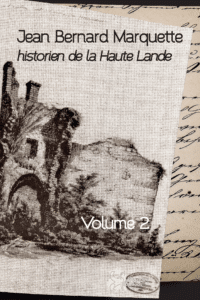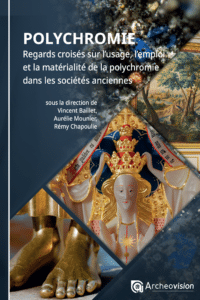UN@ est une plateforme d'édition de livres numériques pour les presses universitaires de Nouvelle-Aquitaine
Type de document : Chapitre de livre
Au cours d’une excursion faite il y a plusieurs années en compagnie de M. J. Labat, celui-ci nous a révélé l’existence d’une bien curieuse épitaphe. Elle se trouve dans la très vieille église de Saint-Martin-de-Bachac, actuellement dans la commune de Ruffiac, en Lot-et-Garonne. La paroisse de Bachac dépendait au XVIIIe siècle de l’archiprêtré de Sadirac dans le diocèse de Bazas.
par Markus Schlicht
Une sculpture polychrome privée de son revêtement coloré est une sculpture mutilée. N’existe alors plus que le support tridimensionnel, la pierre façonnée par le sculpteur en vue de recevoir un épiderme multicolore.
When one approaches the subject of 18th century colours, the common thought is immediately oriented towards pastel or even dull colours. Tapestries from this period are no exception to the rule.
Dominant un des plus beaux paysages de la région, ancien chef-lieu d’un archiprêtré qui, au XVIIIe siècle, s’étendait sur la rive droite de la Garonne jusqu’aux portes de La Réole, l’église de Sadirac est aujourd’hui bien déchue.
Il y a un siècle environ, Léo Drouyn signalait, à Cudos, l’existence d’un tumulus, celui de La Roche, situé à proximité du domaine de La Beyrie. À la suite des recherches effectuées par Louis Cadis et par nous-même, nous avons pu inventorier neuf tertres funéraires, et la liste est certainement loin d’en être close.
Elle s’élevait en bordure du chemin allant de Saint-Loubert à Campin, au sommet d’une légère éminence dominant le plateau environnant[1]. Nous ne savons pratiquement rien de son architecture, aucun historien ou archéologue n’ayant daigné nous laisser une description de cette chapelle.
Il existe sur les bords du Ciron, dans sa traversée de la commune de Bernos, plusieurs grottes, sur la rive gauche face au moulin de Labarie et au pont de Pessan, sur la rive droite à Lauvergne (fig. 1).
Lorsque, il y a huit ans de cela, les Cahiers du Bazadais commencèrent à paraître, nous avions songé à présenter à leurs lecteurs les principales richesses artistiques de notre région. L’ampleur de la tâche ainsi que la nécessité de varier les publications de la revue nous firent renoncer momentanément à un tel projet.
Nous avons présenté, dans le dernier numéro des Cahiers, la fin de l’inventaire archéologique de la commune de Bazas. M. J.P. Mohen ayant bien voulu consacrer une étude aux découvertes faites lors des fouilles des tumulus de Marimbault, nous avons reporté l’inventaire archéologique des communes de Bernos, Cudos, Gajac, Gans, Le Nizan et Lignan aux numéros suivants.
Cachée dans la verdure, dominant à flanc de coteau le vallon au fond duquel coule le ruisseau de Saint-Vincent, l’église de Saint-Michel-de-Ia-Prade est, de nos jours, bien oubliée des Bazadais (fig. 1).
Au cours de travaux effectués il y a quelques années au lieu-dit Saint-Vivien, à l’ouest de la ville, lors du captage d’une source, les terrassiers découvrirent plusieurs fragments de poterie.
Ainsi que nous l’avions indiqué dans notre dernier article[2], il nous avait été difficile d’étudier comme nous l’aurions souhaité, la tête sculptée encastrée dans le mur de soutien du jardin de la cathédrale.



